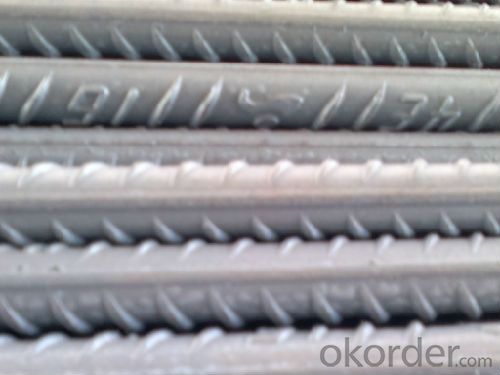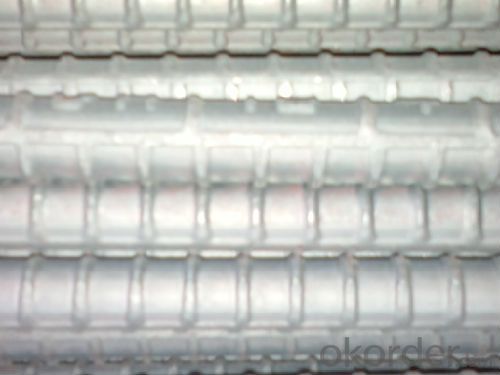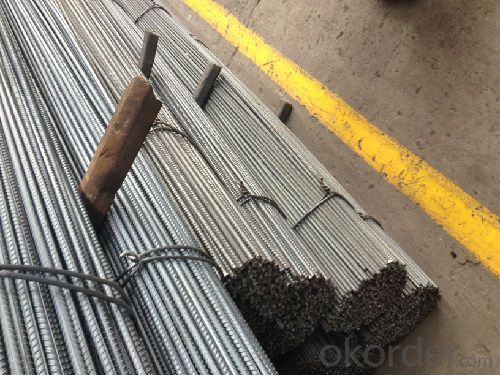Deformed Steel Bar Iron Bars for Construction
- Loading Port:
- Tianjin
- Payment Terms:
- TT or LC
- Min Order Qty:
- 24 m.t.
- Supply Capability:
- 35000 m.t./month
OKorder Service Pledge
OKorder Financial Service
You Might Also Like
Product Description:
OKorder is offering Deformed Steel Bar Iron Bars for Construction at great prices with worldwide shipping. Our supplier is a world-class manufacturer of steel, with our products utilized the world over. OKorder annually supplies products to European, North American and Asian markets. We provide quotations within 24 hours of receiving an inquiry and guarantee competitive prices.
Product Applications:
Deformed Steel Bar Iron Bars for Construction are ideal for structural applications and are widely used in the construction of buildings and bridges, and the manufacturing, petrochemical, and transportation industries.
Product Advantages:
OKorder's Deformed Steel Bar Iron Bars for Construction are durable, strong, and resist corrosion.
Main Product Features:
· Premium quality
· Prompt delivery & seaworthy packing (30 days after receiving deposit)
· Corrosion resistance
· Can be recycled and reused
· Mill test certification
· Professional Service
· Competitive pricing
Product Specifications:
iron bars for construction
Diameter 10-40mm
Grade: ASTM A615 Gr60; BS4999 Gr500
Size: 10#-40#
Length: 6M-12M
| Name | Deformed bar, steel rebar |
| Place of origin | China (mainland) |
| Material | HRB335, HRB400, HRB500, BS4449:2008 GR.460B / GR.500B ASTM A615 GR.40 / GR.60 |
| Standard | ASTM, BS, GB |
| Diameter | 8mm-50mm |
| Length | 9m,12m |
| Application | Widely used in construction industry for reinforcing concret |
| Trasportation | By sea(20' 40' container, BULK VESSEL), By rail |
FAQ:
Q1: Why buy Materials & Equipment from OKorder.com?
A1: All products offered byOKorder.com are carefully selected from China's most reliable manufacturing enterprises. Through its ISO certifications, OKorder.com adheres to the highest standards and a commitment to supply chain safety and customer satisfaction.
Q2: How do we guarantee the quality of our products?
A2: We have established an advanced quality management system which conducts strict quality tests at every step, from raw materials to the final product. At the same time, we provide extensive follow-up service assurances as required.
Q3: How soon can we receive the product after purchase?
A3: Within three days of placing an order, we will begin production. The specific shipping date is dependent upon international and government factors, but is typically 7 to 10 workdays.
Q4: What makes stainless steel stainless?
A4: Stainless steel must contain at least 10.5 % chromium. It is this element that reacts with the oxygen in the air to form a complex chrome-oxide surface layer that is invisible but strong enough to prevent further oxygen from "staining" (rusting) the surface. Higher levels of chromium and the addition of other alloying elements such as nickel and molybdenum enhance this surface layer and improve the corrosion resistance of the stainless material.
Q5: Can stainless steel rust?
A5: Stainless does not "rust" as you think of regular steel rusting with a red oxide on the surface that flakes off. If you see red rust it is probably due to some iron particles that have contaminated the surface of the stainless steel and it is these iron particles that are rusting. Look at the source of the rusting and see if you can remove it from the surface.
Images:



- Q:What is the average lifespan of steel rebars in marine environments?
- Several factors can influence the average lifespan of steel rebars in marine environments. On the whole, these rebars tend to last between 50 and 100 years in such settings. This estimate considers the corrosive properties of saltwater, which can hasten the decay of steel structures. Furthermore, the quality of the steel, the marine structure's design and construction, and maintenance practices can all impact the rebars' lifespan. Regular inspections, the application of protective coatings, and appropriate maintenance can effectively prolong the rebars' longevity in marine environments.
- Q:Can steel rebars be used in structures with high thermal insulation requirements?
- In structures requiring high thermal insulation, the use of steel rebars is possible, but precautions must be taken to minimize thermal bridging. Steel, being an efficient conductor of heat, can compromise the insulation of the structure if the rebars are not adequately insulated. However, there are various strategies available to tackle this issue. One possible approach involves utilizing rebars with lower thermal conductivity, like stainless steel rebars, which offer superior insulation properties compared to regular steel rebars. Another option is to thermally separate the rebars by applying insulation materials or coatings around them to prevent heat transfer. Additionally, meticulous detailing and design play a crucial role in reducing thermal bridging. Ensuring proper embedding of rebars within the insulation layer and avoiding direct contact between the rebars and the structure's exterior or interior surfaces can effectively minimize heat transfer. In conclusion, although steel rebars can be used in structures with high thermal insulation requirements, it is essential to implement appropriate measures to address thermal bridging and maintain the desired insulation level.
- Q:How are steel rebars protected against mechanical damage during construction?
- Steel rebars are protected against mechanical damage during construction through a process called bar caging. This involves enclosing the rebars in a wire mesh or steel cage, which acts as a protective barrier and prevents them from being easily damaged or displaced during the construction process. Additionally, rebars can also be covered with plastic sleeves or caps to provide an extra layer of protection.
- Q:Why can't grounding steel be used?
- The edge of the thread of the thread will have a point charge accumulation discharge, and the uniform dispersion of the ground current is unfavorable
- Q:Can steel rebars be used in road and bridge barriers?
- Yes, steel rebars can be used in road and bridge barriers. Steel rebars are commonly used in construction as reinforcement in concrete structures, including road and bridge barriers, due to their high tensile strength and durability.
- Q:Are there any alternatives to steel rebars?
- There are multiple options available instead of steel rebars. One such option is the utilization of fiber-reinforced polymer (FRP) rebars, which consist of high-strength fibers embedded in a polymer matrix. FRP rebars present various advantages over traditional steel rebars, such as resistance to corrosion, high tensile strength, and lightweight characteristics. Moreover, they are non-magnetic and electrically non-conductive, making them appropriate for areas with concerns regarding electromagnetic interference. Another alternative is the employment of basalt rebars, which are manufactured from fibers derived from basalt rock. Basalt rebars offer similar benefits to FRP rebars, including corrosion resistance and high tensile strength. Furthermore, certain manufacturers have developed alternative materials like bamboo, carbon fiber, and glass fiber rebars, which have also displayed potential in specific applications. Nevertheless, it is crucial to consider that the selection of alternative rebars depends on the specific requirements of a project, and factors like cost, availability, and adherence to local building codes should be taken into account when choosing an alternative to steel rebars.
- Q:How do steel rebars help in load distribution within a structure?
- Steel rebars, also known as reinforcing bars, play a crucial role in load distribution within a structure. They are extensively used in concrete structures, such as buildings, bridges, and highways, to enhance their strength and durability. The primary purpose of steel rebars is to provide tensile strength to the concrete. While concrete is excellent in compression, it is relatively weak in tension. Any structure subjected to loads, whether from the weight of the building itself or external forces, will experience both compression and tension forces. By placing steel rebars within the concrete, they act as reinforcement and resist tensile forces. When an external load is applied to the structure, the rebars carry a significant portion of the tension forces generated. This prevents the concrete from cracking or failing under the applied load. Moreover, steel rebars help in distributing the load throughout the structure. When a load is applied to a structure, it creates stress that is distributed across the various components. The presence of rebars allows for a more even distribution of these stresses, reducing the concentration of forces in specific areas. This prevents localized failures and ensures that the load is evenly dispersed across the structure, improving its overall strength and stability. Another important aspect of steel rebars is their ability to bond with concrete. The rough surface of the rebars prevents them from slipping or separating from the concrete, ensuring a strong bond between the two materials. This bond further enhances the load distribution by allowing the rebars to effectively transfer the tensile forces to the surrounding concrete. In summary, steel rebars play a vital role in load distribution within a structure. They provide the necessary tensile strength to resist tension forces, distribute the load evenly across the structure, and bond with the concrete, ensuring a robust and stable construction. Without steel rebars, concrete structures would be significantly weaker and more susceptible to cracking or failure under load.
- Q:What are the different types of steel rebars used in precast concrete constructions?
- Precast concrete constructions commonly utilize various types of steel rebars to enhance the strength and durability of the structures. The following are some of the commonly employed rebars along with their distinctive features: 1. Mild Steel Rebars: These rebars, widely used due to their affordability and easy availability, possess a low carbon content. They are suitable for most precast concrete applications. 2. High Strength Deformed (HSD) Rebars: HSD rebars, crafted through the hot rolling process, exhibit a superior yield strength compared to mild steel rebars. Their surface is characterized by deformations that enhance their grip with concrete. These rebars are commonly employed in heavy-duty structures or situations necessitating additional strength. 3. Carbon Steel Rebars: Carbon steel rebars, made from carbon steel alloys, possess a higher carbon content than mild steel rebars. Consequently, they offer improved strength and durability. They are often utilized in precast concrete constructions requiring high tensile strength. 4. Epoxy-Coated Rebars: To safeguard against corrosion and extend their lifespan, these rebars are coated with an epoxy layer. Epoxy-coated rebars find common application in precast concrete constructions exposed to harsh environments or possessing high moisture content. 5. Stainless Steel Rebars: Constructed from stainless steel alloys, these rebars exhibit excellent corrosion resistance. They are employed in precast concrete constructions exposed to corrosive substances such as seawater or chemicals. It is crucial to select the appropriate rebar type for a precast concrete construction, considering specific project requirements such as load-bearing capacity, durability, and environmental conditions. Collaborating with a structural engineer or construction professional can aid in determining the most suitable rebar type for a particular application.
- Q:Can steel rebars be used in composite construction systems?
- Yes, steel rebars can be used in composite construction systems. Steel rebars are commonly used as reinforcement in composite structures to enhance their strength and durability. The rebars are embedded within the composite materials, such as concrete or fiber-reinforced polymers, to provide additional tensile strength and structural integrity. This combination of materials allows for a more efficient and cost-effective construction system.
- Q:Are there any limitations on using steel rebars in cold climates?
- Yes, there are some limitations on using steel rebars in cold climates. The main concern is the potential for corrosion due to the presence of moisture, salt, and de-icing chemicals commonly used on roads and bridges during winter. When steel rebars are exposed to these elements, they can rust and weaken over time, compromising the structural integrity of the concrete. To mitigate this issue, several measures can be taken. One common practice is to use epoxy-coated rebars, which provide a protective layer against moisture and chemicals. Additionally, stainless steel rebars can be used, as they are highly resistant to corrosion. However, these options can be more expensive than traditional steel rebars. Furthermore, the construction process in cold climates can also present challenges. Concrete cures and gains strength more slowly in low temperatures, which can impact the overall project timeline. Special precautions, such as heating the concrete or using accelerators, may be necessary to ensure proper curing. It is important to consult local building codes and regulations specific to cold climates to ensure compliance and safety. Engineering professionals experienced in cold weather construction practices can provide valuable insights and recommendations to address the limitations associated with using steel rebars in these conditions.
1. Manufacturer Overview |
|
|---|---|
| Location | |
| Year Established | |
| Annual Output Value | |
| Main Markets | |
| Company Certifications | |
2. Manufacturer Certificates |
|
|---|---|
| a) Certification Name | |
| Range | |
| Reference | |
| Validity Period | |
3. Manufacturer Capability |
|
|---|---|
| a)Trade Capacity | |
| Nearest Port | |
| Export Percentage | |
| No.of Employees in Trade Department | |
| Language Spoken: | |
| b)Factory Information | |
| Factory Size: | |
| No. of Production Lines | |
| Contract Manufacturing | |
| Product Price Range | |
Send your message to us
Deformed Steel Bar Iron Bars for Construction
- Loading Port:
- Tianjin
- Payment Terms:
- TT or LC
- Min Order Qty:
- 24 m.t.
- Supply Capability:
- 35000 m.t./month
OKorder Service Pledge
OKorder Financial Service
Similar products
New products
Hot products
Related keywords





























